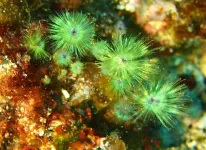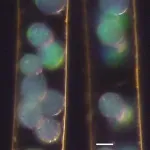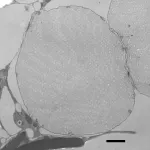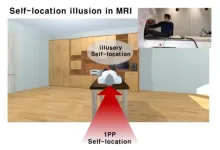(Press-News.org) Compartments of consistently sized, tightly packed microspheres are what makes some brown algae shimmer like opal. The Kobe University discovery not only sheds light on the mechanism behind the alga’s structural coloration, it is also the first to spot the effect in an order of brown algae other than the two where it was known to occur.
Most brown algae are indeed yellowish-brown, but scuba divers noticed that a species resembling Sporochnus in the order Sporochnales shimmers like peacock feathers in yellow, bright green or blue when direct light is shone on them. Kobe University phycologist KAWAI Hiroshi says: “Being a diver myself, I have observed and collected Sporochnus species many times in many places, but I have never seen an individual that appeared to glow green, so I was interested in analyzing it.” An opal-like play-of-color, or “iridescence,” is known to occur in two other orders of brown algae, but never in Sporochnales, and in particular, not in the seaweed species that has become a conversation topic among divers. “I wanted to clarify the mechanism behind this green glow, and also wondered why this phenomenon does not commonly occur in other Sporochnus species,” says Kawai.
One reason why no-one else has described the phenomenon might be the fragility of the organism. Kawai explains: “Generally speaking, Sporochnus species are very fragile, and are often damaged within a short period of time after being collected and removed from the sea, making it very difficult to observe the details of the intact organism. Therefore, we dived to a 25-m depth in Kushimoto, the southernmost point of Japan’s main island, to observe and photograph the algae. We then collected some specimens, placed them in a large amount of seawater to prevent damage, and rushed them to the laboratory to conduct detailed observations on the healthy algae, also using a specialized fixation method to preserve their delicate features.”
The effort paid off. In the European Journal of Phycology, the group now published not only stunning photos of the iridescent algae, but also their analysis using electron-microscopic images to explain where the effect comes from. Similar to other brown algae exhibiting structural coloration, the organisms have cellular compartments that are packed with microspheres of very consistent size. These so-called “iridescent bodies” reflect green light much more than other colors, which is the source of the color effect. The researchers explain in the paper, “It is known that regular arrangement of fine structures such as crystals and multilayered membranes cause structural colouration in both organic and inorganic structures.” The effect might thus be a result of the interaction of light reflected from different “layers” of the fine structures, extinguishing some colors and letting through others.
To support this hypothesis, the Kobe University team compared two Sporochnus species, the one with and another without shimmering colors. In both species, they found that cells at the ends of their photosynthetic filaments contained spherical bodies that brightly reflect light, and that are therefore called “iridescent bodies.” These iridescent bodies were in both cases tightly filled with small nanospheres, but in the species that does not exhibit actual iridescence, the nanospheres fused and resulted in the compartment filled with globules of very different sizes. On the other hand, in the iridescent brown alga, the nanospheres remained of uniform size between 130 and 160 nanometers, which is consistent with how structural coloration amplifies only select colors based on the size and spacing of the fine structures.
“Now that we have some understanding of the mechanism of the structural coloration, we would like to clarify the ecological relevance of this property and the evolutionary relationship between the structure and mechanism in different brown algae exhibiting the phenomenon,” explains Kawai. While in those other brown algae iridescence has been linked to photosynthesis, the alga Kawai studied grows in deeper waters, making it unlikely that the purpose is the same. Kawai says: “The iridescent bodies also contain highly reactive substances that, when released by the rupture of iridescent bodies, destroy the entire cell in a short time. Since these algae grow in waters where algae-eating fish are abundant, the reactive substances are thought to play a role in repelling grazers. We thus believe that the structural coloration may play a role in communication among organisms, such as camouflage or a warning to grazers.”
This research was conducted in collaboration with a researcher from Hokkaido University.
Kobe University is a national university with roots dating back to the Kobe Commercial School founded in 1902. It is now one of Japan’s leading comprehensive research universities with nearly 16,000 students and nearly 1,700 faculty in 10 faculties and schools and 15 graduate schools. Combining the social and natural sciences to cultivate leaders with an interdisciplinary perspective, Kobe University creates knowledge and fosters innovation to address society’s challenges.
END
What makes some brown algae shimmer and others not?
2024-05-20
ELSE PRESS RELEASES FROM THIS DATE:
Seeking stronger steel, systematic look at 120 combinations of alloy elements provides clues
2024-05-20
Decarbonization of automobiles not only requires a shift from gasoline engines to electric motors, but also quality steel parts that help the motors run while lessening the weight of vehicles. High-performance steel materials can offer quieter rides and resist the wear and tear from high-speed rotation in motors. To create them, the process of modifying the steel surface with carbon, nitrogen, and alloy elements needs to be optimized.
To understand the interactions between elements in steel, a systematic investigation ...
Tricking the Brain’s inner GPS: Grid cells responses to the illusion of self-location
2024-05-20
Dr. Hyuk-June Moon from the Bionics Research Center at the Korea Institute of Science and Technology (KIST), in collaboration with Prof. Olaf Blanke’s team at the Swiss Federal Institute of Technology Lausanne (EPFL), has successfully induced self-location illusions with multi-sensory virtual reality (VR) in the MRI scanner and observed corresponding changes in the human brain's grid cell activity.
The brain is known to contain grid cells and place cells, which perform global positioning system (GPS) functions that allow us to recognize where we are. While ...
Gallbladder cancer rises among Black Americans as cases decline in other groups
2024-05-20
WASHINGTON, DC (May 20, 2024) — Gallbladder cancer rates have been stable or declining for most Americans over the last two decades, but cases have steadily risen among Blacks, with growing numbers not being diagnosed until later stages, according to a study scheduled for presentation at Digestive Disease Week® (DDW) 2024.
“Gallbladder cancer diagnosis at late stage can be highly detrimental,” said lead author Yazan Abboud, MD, internal medicine resident at Rutgers University New Jersey Medical School. “This could be due to a lack of timely ...
Biomarker for gastric cancer and other cancer studies set for digestive disease week
2024-05-20
Washington (May 14, 2024) — Cancer-related studies, including a diagnostic tool for gastric cancer and trends in gallbladder and colorectal cancers, will be presented this week at Digestive Disease Week (DDW) 2024. Abstracts are available to registered media, and press releases are available where noted. Studies are embargoed until 12:01 a.m. EDT the day of presentation, unless otherwise noted.
Here are summaries of the new research on the schedule:
Oral microbiome signatures as potential biomarkers for gastric cancer risk assessment, Abstract 949, will be presented Monday, May 20, at 4:15 p.m. EDT. (A press release is available upon request. Embargoed until 12:01 a.m. EDT ...
Endoscopic studies presented at Digestive Disease Week
2024-05-20
Washington (May 14, 2024) — Studies featuring endoscopic and laparoscopic procedures, including patient views on artificial intelligence in endoscopy and hazards to healthcare personnel of smoke-producing procedures, will be presented this week at Digestive Disease Week (DDW) 2024. Abstracts are available to registered media, and press releases are available where noted. Research is embargoed until 12:01 a.m. EDT the day of presentation, unless otherwise noted.
Here are summaries of the new research:
Patients’ sentiments ...
Hunger hormone, antibiotic-induced weight gain, and sleep and digestive health explored at Digestive Disease Week
2024-05-20
Washington (May 14, 2024) — Studies exploring the hunger hormone, weight-loss drugs, sauerkraut and antibiotic weight gain, the impact of physician gender on care, and the relationship between sleep patterns and digestive diseases will be presented this week at Digestive Disease Week (DDW) 2024. Abstracts are available to registered media. Embargos lift at 12:01 a.m. EDT on the day they are presented unless otherwise noted.
Here are summaries of the new research:
Performance of a machine-learning gene ...
Innovative 3D printing could revolutionise treatment for cataracts and other eye conditions
2024-05-20
Peer-reviewed – Proof-of-concept study
University of East Anglia researchers have made a significant breakthrough in ocular device technology with the introduction of a novel resin for 3D printing intraocular devices. This innovation has potential to enhance the manufacture of eye implants universally used in cataract and refractive surgeries.
An artificial intraocular lens (IOL) is primarily required for people with cataracts, a condition where the eye’s natural lens becomes cloudy, obscuring vision.
They can also be also used to correct refractive errors such as myopia (nearsightedness), ...
Rigid approach to teaching phonics is ‘joyless’ and is failing children, experts warn
2024-05-20
Experts have released robust research to show that phonics should be taught hand-in-hand with reading and writing to encourage true literacy and a love of reading, not through narrow synthetic phonics.
There is widespread disagreement globally across academic and educational spheres about the best way to teach children to learn to read and write. Despite a growing international trend towards a narrow approach to synthetic phonics, experts suggest there is a ‘better way’ to teach reading and writing.
In England, the system is among the most prescriptive in the world with ‘synthetic phonics’ being the ...
Meerkat chit-chat
2024-05-20
EMBARGOED UNTIL MONDAY, 20 MAY 2024, 01:01 CEST (00:01 BST/London Time)
Meerkats use two different types of vocal interactions to stay in touch with their group mates. Sometimes the call simply broadcasts information, whereas other times meerkats engage in a call exchange with their neighbours, as researchers from the Centre for the Advanced Study of Collective Behaviour at the University of Konstanz and the Max Planck Institute of Animal Behavior present in a new publication published on 20 May in Philosophical Transactions of the Royal Society B.
What does it sound like ...
Extreme heat associated with children’s asthma hospital visits
2024-05-20
EMBARGOED UNTIL: 2:15 p.m. PT, May 19, 2024
Session: A95 – Climate Change and Health Disparities in Lung Disease
Extreme Heat and Asthma Hospitalizations in Children in California (2017-2020)
Date and Time: Sunday, May 19, 2024, 2:15 p.m. PT
Location: San Diego Convention Center, Room 24A-C (Upper Level)
ATS 2024, San Diego – For children seeking care at a California urban pediatric health center, extreme heat events were associated with increased asthma hospital visits, according to research published at the ATS 2024 International Conference.
“We found ...





